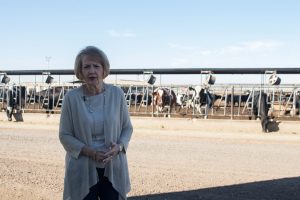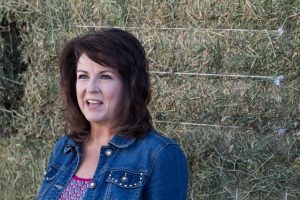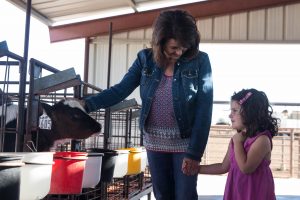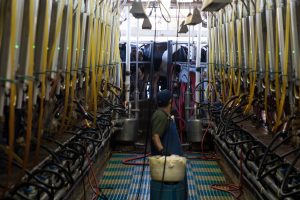- Slug: BC-CNS-Women farmers. About 800 words.
- Video and photos available (thumbnails and captions below)
- Three graphics are available
By SHAYLA HYDE
Cronkite News
BUCKEYE — Sine Kerr cultivated her love for farming as a girl in rural Buckeye, participating in her local 4-H group and playing at friends’ houses whose families had farms and ranches.
“At the age of 18 I became a farmer,” Kerr said, marrying Buckeye dairyman Bill Kerr.
About 45 percent of the farmers in Arizona are women, making it the state with the highest proportion of women farmers in a declining industry, according to the 2012 Census of Agriculture.
Kerr, now 56, chairs the women’s leadership committee of the Arizona Farm Bureau, promoting agriculture and her experience as a female farmer.
“Ag needs a voice,” Kerr said.
Rise and fall of farming in U.S.
Farming is on the decline across the country, dropping about four percent from 2007 to 2012. Women farmers decreased two percent in that same period, according to the 2012 Census of Agriculture.
Women farmers are typically part of a family operation, even working part-time while holding down other jobs, according to Sherry Saylor, who chairs the American Farm Bureau Women’s Leadership program.
Saylor, also a member of the Arizona Farm Bureau, said corporations are buying smaller farms whose owners could not afford to stay in business, shrinking the number of farms across the country. According to the Arizona Farm Bureau, farmers and ranchers make up two percent of the nation’s population.
Saylor said the opening of niche markets and smaller crops such as micro greens in the West and rise in the demand for locally grown food products may account for the high numbers of women farmers in Colorado, Arizona and Texas, which has the highest number of women farmers. And the rise in Arizona farmers markets allows for smaller crops and specialty items to be grown and sold in a local setting, she said.
According to Kerr, there is also a large percentage of women farmers on the Navajo Nation reservation.
Saylor said the Arizona Farm Bureau conducted a focus group to gauge how consumers view women farmers. The group said they trusted women and could relate to them better than men.
“For women, I think it’s time to embrace that,” Saylor said. As about 90 percent of farms in the U.S. are family-owned and operated, Saylor said she and other women farmers need to take a vested interest in their business and how consumers view it.
“It’s your livelihood,” Saylor said.
“Farming is such an attractive livelihood,” Sine Kerr said. “Women relate to women. We have a great opportunity to get that message out there.”
Kerr said female farmers face stereotypes.
“I hear comments like ‘oh you don’t look like a farmer,” Kerr said. “It’s kind of demeaning to think people have this image, and when you don’t fit that mold they’re disappointed.”
Women farmers also face some of the same challenges as any farmer: making the economics work when the cost of producing a gallon of milk is less than the sell price, or facing weather conditions like monsoons that destroy crops.
But Kerr said farming is worth the struggle.
“You have to love it,” Kerr said. “You have to have a great passion for it.”
Living the farmer’s dream
Kerr and her then-boyfriend began their farming journey in 1980 with a scant 15 cows on his parents’ dairy farm. Her Friday night date nights consisted of milking cows and learning all the facets of the dairy operation.
“I can relate to every operation on the farm,” Kerr said. She had her struggles, like learning not to pop the clutch on the tractor after accidentally knocking workers off the trailer she was pulling. Now she administers operations on the third-generation farm.
“I guess she fell in love with it,” her husband, Bill Kerr said. The couple would do all their farm tasks in the morning and spend the rest of their day outdoors water skiing, hunting and camping.
Ten years after starting, the Kerrs bought a larger piece of property in Buckeye to start growing their dairy herd. Kerr said they started adding cows as they could afford it, and now they run about 1,100 milking cows on 100 acres and about 800 heifers at her in-laws farm on the other side of the city.
In addition to the dairy cows, the Kerrs lease 400 acres to grow alfalfa, oats, rye grass, sorghum and corn to finance their operation.
Kerr now manages the operation’s finances but leaves the daily operation to her son, who lives on the farm. Milk is marketed through the United Dairymen of Arizona coop and sold in local stores like Albertson’s and Safeway.
“This isn’t just a job,” Kerr said. “It’s part of our heritage and our legacy. “It’s the most incredible lifestyle. It’s the best place to raise your children. There’s nothing like it.”
(Video by Blakely McHugh/Cronkite News)
^__=




